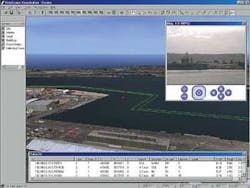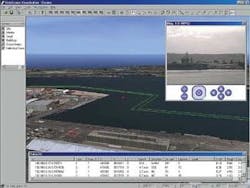By Ben Ames
SAN DIEGO — A naval base covers a huge area, encompassing bustling ports and harbors full of people. That makes it very hard to guard against intruders.
Now the U.S. Navy has tapped VistaScape Security Systems in Atlanta to build a security platform for the sprawling San Diego Naval Base. The new system moves a giant step beyond funneling closed-circuit TV pictures from scattered surveillance cameras into a room full of bored security guards.
null
Instead, the Security Data Management System (SDMS) integrates digital feeds from a large number of sensors that detect not just visible motion, but also infrared and other signals. The system then notifies guards only when it finds something out of the ordinary.
The SDMS's automated detection and response software follows rules that the end-user dictates when he installs it. Configuring the system's software is far more complex than configuring the security settings on a computer firewall or Web browser.
"SDMS enables the customer to enforce his own physical security rules as the policy," says Glenn McGonnigle, a board member and senior executive at VistaScape. "That's been happening for the last ten years in information technology, and now it's happening to physical security."
The installation at the San Diego Naval Base monitors nearly 50 sensors and has been used for several months to protect ships at port from potential terrorist attack, such as the explosion on the USS Cole in Yemen Oct. 12, 2000 that killed 17 sailors.
By routing all that data to a single command and control center where it is automatically monitored, the system frees security staff to be mobile, instead of sitting and staring at screens.
"One high school-educated guard in a communications center can be effective in watching no more than six to eight TV screens. And even then, he can be distracted," McGonnigle says. That amounts to what IT experts call a scalability problem, as customers try to add greater numbers and types of sensors.
To keep costs down, designers built SDMS as a standardized software tool, not a custom solution. It runs on standard IP networks, using commercial-off-the-shelf (COTS) computing equipment from companies such as Intel and Microsoft. Although those 50 sensors generate terabytes of data every day, the sensors handle the flow by not saving everything they see.
Rather, the software traces a virtual security zone around each target. When any sensor detects an event in the zone, such as an unexpected person, truck, or boat, it assigns the intruder a GPS coordinate. It sends only that strategic information back to the main server, which overlays the new record into a map of the entire harbor. The final effect looks a lot like the flight simulator game on a PC.
Then the pre-programmed rules kick in. SDMS triggers one action if the intruder penetrates within a given perimeter around a target, and another action if the intruder gets even closer. Those reactions can include: turning on flood lights, zooming in with the nearest camera, recording a video feed, alerting guards, even feeding pictures to a guard's handheld computer on the site.
Every step is automated because SDMS is based on the security tools that protect computer targets from hackers.
"The analogy is so pure between information security and physical security," McGonnigle says. "A policy is only as good as your ability to enforce it. The volume and speed of attacks in the cyber world demand automation. But we found that civilian and commercial organizations in the physical world were lacking automation."
New VistaScape installations that have not yet been launched include deals with the U.S. Border Patrol, a major commercial airport, a prison system, and several refineries in the oil and gas industry, Vista Scape officials say. Each has its own security concerns, but the technology can handle surveillance on any type of sensor, be it a camera, radar, sonar, chemical or biohazard. The company has a particular strength in thermal imaging, through a partnership announced in February with experts at FLIR Systems of Portland, Ore., an infrared imaging firm.




